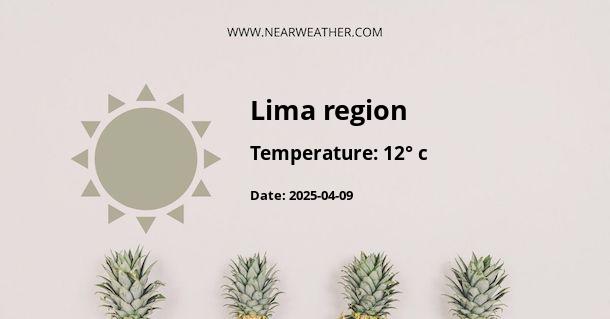Climate and Weather in the Region of Lima, Peru
The region of Lima, Peru is known for its unique climate and diverse weather patterns. Situated along the central-western coast of the country, the region experiences a desert-like climate with minimal rainfall and mild temperatures year-round. Understanding the climate and weather patterns of Lima is essential for visitors and residents alike, as it influences daily life, agriculture, and tourism in the region.
Annual Temperature and Weather Patterns
The region of Lima experiences a mild and temperate climate throughout the year, with average temperatures ranging from 15°C to 22°C (59°F to 72°F). The region is characterized by two distinct seasons: a mild, humid winter from May to October, and a warm, dry summer from November to April. The temperatures in Lima exhibit minimal variation, creating a relatively consistent climate year-round.
One of the most notable weather patterns in Lima is the garúa, a persistent fog that blankets the coastal areas during the winter months. The garúa is a result of the interaction between the cool offshore waters of the Humboldt Current and the warm desert air, creating a unique meteorological phenomenon that impacts visibility and the overall atmospheric conditions in the region.
Precipitation and Rainfall Patterns
Lima is situated in one of the driest deserts in the world, the Atacama Desert, and as a result, experiences very low levels of precipitation. The average annual rainfall in Lima is approximately 10 millimeters (0.39 inches), making it one of the driest capital cities in the world. Most of the limited rainfall occurs during the winter months, with the summer season being exceptionally dry.
The scarcity of rainfall in Lima has significant implications for agriculture, water supply, and the overall ecosystem of the region. The reliance on irrigation systems and innovative water management strategies is essential for sustaining agricultural activities in the arid climate of Lima.
Impact of El Niño and La Niña Phenomena
The climate of Lima is also influenced by the El Niño and La Niña phenomena, which can have profound effects on weather patterns and precipitation levels. El Niño events, characterized by the warming of sea surface temperatures in the Pacific Ocean, often result in increased rainfall and flooding in the region. Conversely, La Niña events, associated with cooler sea surface temperatures, can lead to drier conditions and reduced precipitation in Lima.
Weather Extremes and Natural Disasters
While the region of Lima generally experiences mild and consistent weather, it is also susceptible to occasional weather extremes and natural disasters. The coastal location makes Lima vulnerable to events such as coastal erosion, landslides, and earthquakes. The city has experienced devastating earthquakes in the past, emphasizing the importance of preparedness and infrastructure resilience in the face of potential natural disasters.
Conclusion
The climate and weather patterns of the region of Lima, Peru, are characterized by mild temperatures, minimal precipitation, and unique meteorological phenomena such as the garúa. Understanding the climate of Lima is essential for various sectors, including agriculture, tourism, and urban planning. Despite its arid climate, Lima's weather patterns and resilience to natural disasters make it a fascinating and dynamic region to study and experience.
A - Lima region's Latitude is -12.003890 & Longitude is -76.638893.
A - Weather in Lima region is 15° today.
A - Climate Conditions in Lima region shows overcast clouds today.
A - Humidity in Lima region is 80% today.
A - Wind speed in Lima region is 2.81 km/h, flowing at 274° wind direction. today.
